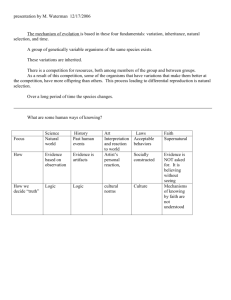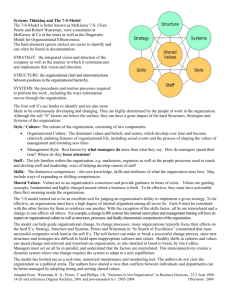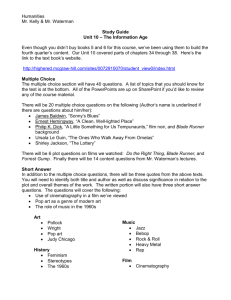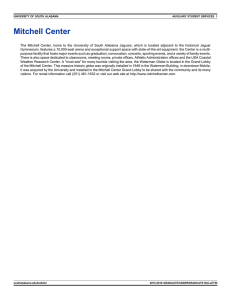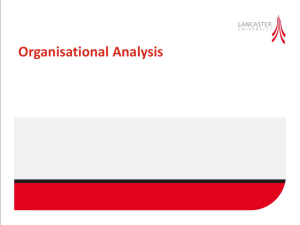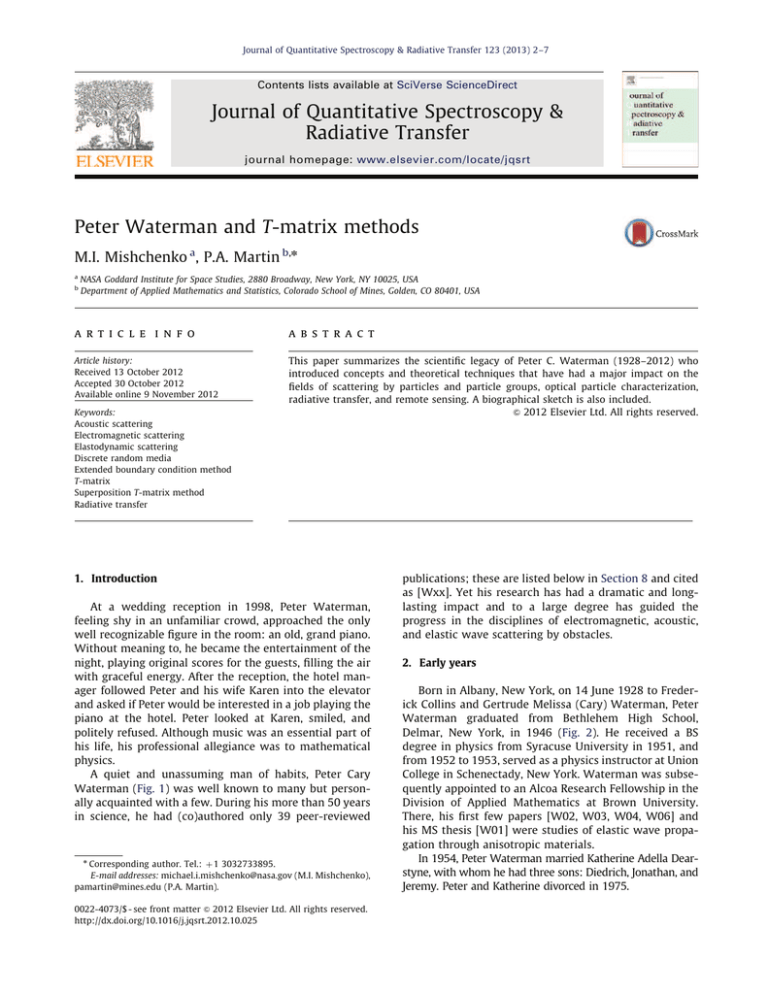
Journal of Quantitative Spectroscopy & Radiative Transfer 123 (2013) 2–7
Contents lists available at SciVerse ScienceDirect
Journal of Quantitative Spectroscopy &
Radiative Transfer
journal homepage: www.elsevier.com/locate/jqsrt
Peter Waterman and T-matrix methods
M.I. Mishchenko a, P.A. Martin b,n
a
b
NASA Goddard Institute for Space Studies, 2880 Broadway, New York, NY 10025, USA
Department of Applied Mathematics and Statistics, Colorado School of Mines, Golden, CO 80401, USA
a r t i c l e in f o
abstract
Article history:
Received 13 October 2012
Accepted 30 October 2012
Available online 9 November 2012
This paper summarizes the scientific legacy of Peter C. Waterman (1928–2012) who
introduced concepts and theoretical techniques that have had a major impact on the
fields of scattering by particles and particle groups, optical particle characterization,
radiative transfer, and remote sensing. A biographical sketch is also included.
& 2012 Elsevier Ltd. All rights reserved.
Keywords:
Acoustic scattering
Electromagnetic scattering
Elastodynamic scattering
Discrete random media
Extended boundary condition method
T-matrix
Superposition T-matrix method
Radiative transfer
1. Introduction
At a wedding reception in 1998, Peter Waterman,
feeling shy in an unfamiliar crowd, approached the only
well recognizable figure in the room: an old, grand piano.
Without meaning to, he became the entertainment of the
night, playing original scores for the guests, filling the air
with graceful energy. After the reception, the hotel manager followed Peter and his wife Karen into the elevator
and asked if Peter would be interested in a job playing the
piano at the hotel. Peter looked at Karen, smiled, and
politely refused. Although music was an essential part of
his life, his professional allegiance was to mathematical
physics.
A quiet and unassuming man of habits, Peter Cary
Waterman (Fig. 1) was well known to many but personally acquainted with a few. During his more than 50 years
in science, he had (co)authored only 39 peer-reviewed
n
Corresponding author. Tel.: þ 1 3032733895.
E-mail addresses: michael.i.mishchenko@nasa.gov (M.I. Mishchenko),
pamartin@mines.edu (P.A. Martin).
0022-4073/$ - see front matter & 2012 Elsevier Ltd. All rights reserved.
http://dx.doi.org/10.1016/j.jqsrt.2012.10.025
publications; these are listed below in Section 8 and cited
as [Wxx]. Yet his research has had a dramatic and longlasting impact and to a large degree has guided the
progress in the disciplines of electromagnetic, acoustic,
and elastic wave scattering by obstacles.
2. Early years
Born in Albany, New York, on 14 June 1928 to Frederick Collins and Gertrude Melissa (Cary) Waterman, Peter
Waterman graduated from Bethlehem High School,
Delmar, New York, in 1946 (Fig. 2). He received a BS
degree in physics from Syracuse University in 1951, and
from 1952 to 1953, served as a physics instructor at Union
College in Schenectady, New York. Waterman was subsequently appointed to an Alcoa Research Fellowship in the
Division of Applied Mathematics at Brown University.
There, his first few papers [W02, W03, W04, W06] and
his MS thesis [W01] were studies of elastic wave propagation through anisotropic materials.
In 1954, Peter Waterman married Katherine Adella Dearstyne, with whom he had three sons: Diedrich, Jonathan, and
Jeremy. Peter and Katherine divorced in 1975.
M.I. Mishchenko, P.A. Martin / Journal of Quantitative Spectroscopy & Radiative Transfer 123 (2013) 2–7
3
3. Multiple scattering
From 1959 to 1965, Waterman worked in the Research
and Advanced Development Division of the Avco Corporation in Wilmington, Massachusetts. He extended his thesis
work with Truell on three-dimensional acoustic scattering
2
(governed by the Helmholtz equation, ðr2 þk Þu ¼ 0, k
being the wavenumber and u the acoustic field) by random
arrangements of identical spherical obstacles, in the spirit
of earlier work by Leslie Foldy and Melvin Lax. The main
result is a formula for the effective wavenumber, K,
assuming that the number of scatterers per unit volume, n,
is small. Waterman and Truell [W09] obtained the formula
ÿ2
ðK=kÞ2 ¼ ½1 þ 2pnk
ÿ2
f ð0Þ2 ÿ½2pnk
f ðpÞ2 ,
ð1Þ
where f ðyÞ is the far-field pattern for scattering of a plane
wave by a single sphere. (The scattered field is asymptotically
r ÿ1 eikr f ðyÞ as r-1, where r and y are spherical polar
coordinates.) Written out, Eq. (1) becomes
Fig. 1. Peter Cary Waterman (1928–2012).
2
K 2 ¼ k þ 4npf ð0Þ þ n2 d2 ,
ð2Þ
where
d2 ¼ ð2p=kÞ2 ½f ð0Þ2 ÿ½f ðpÞ2 :
ð3Þ
The term proportional to n in Eq. (2) is well known. The
second-order coefficient, d2 , had been obtained by Urick and
Ament [1] using a very different argument: the attraction of
Waterman and Truell’s derivation is that it is systematic, with
testable assumptions, and that it has the potential for
extension to other physical situations (such as electromagnetic scattering). In fact, it turned out later that the formula
for d2 , Eq. (3), is wrong: for a review and references, see Ref.
[2]. Nevertheless, the paper [W09] has been very influential:
it has been cited about 500 times and it was reprinted in
1996 in the SPIE Milestone volume on ‘‘Selected papers on
linear optical composite materials,’’ edited by Akhlesh
Lakhtakia.
John Fikioris joined Avco in 1962. He graduated from
Harvard University in 1963 with a PhD thesis on ‘‘The
theory of radially stratified media,’’ written under Ronold
W. P. King’s direction. Fikioris and Waterman [W12]
improved and corrected the analysis in Ref. [W09]. They
also wrote [W12, p. 1414]:
The vector extension of the present work has been
performed, in application to the electromagnetic case.
The procedure and results of this extension will be
described in a subsequent paper.
Fig. 2. Peter Waterman, a 1946 graduate of Bethlehem High School,
Delmar, New York.
That paper did not appear until 2013 [W42]. For a
description of how this came about, see Section 7.
4. The extended boundary condition
Waterman received his PhD degree in applied mathematics from Brown in 1958. His thesis on ‘‘Multiple
scattering of waves’’ [W05] was supervised by Rohn
Truell. This work will be discussed in Section 3.
After graduation, Waterman worked briefly for the
Linde Company (1958), in Tonawanda, New York. There,
he investigated the unmixing of gases in Laval nozzles,
leading to two papers [W07, W08].
In 1965, Waterman published a paper [W13] on
electromagnetic scattering by a perfectly conducting
obstacle in which he introduced the ‘‘extended boundary
condition’’. He was interested in developing a numerical
method for three-dimensional obstacles of arbitrary
shape, one that does not suffer from spurious irregular
frequencies. He describes his formulation as follows:
4
M.I. Mishchenko, P.A. Martin / Journal of Quantitative Spectroscopy & Radiative Transfer 123 (2013) 2–7
The induced surface currents on the obstacle must
produce a field that, through interference, precisely
cancels the incident wave throughout the interior
volume. Employing this statement as a boundary condition leads to an ‘‘extended’’ integral equation, defined
to be one in which the unknown (surface current)
appears in an integral over the surface, whereas the
equation itself is required to hold throughout the
volume bounded by that surface. . . . Mathematical
tractability of the extended integral equation stems
from the observation that one need only make the field
vanish in any portion of the interior volume. The field
can then be shown to vanish everywhere in the interior
[by analytic continuation].
The portion chosen is a ball, and vector spherical wavefunctions (VSWFs) are introduced leading to a linear
algebraic system which is truncated and solved numerically. Results for scattering by an axisymmetric sphere–
cone–sphere shape are presented and compared with
experimental results obtained by N.E. Pedersen. (Waterman would work with Norman and Jeanne Pedersen for
40 years.) The extension to dielectric scatterers was
presented at the 1968 URSI Symposium on electromagnetic theory in Stresa, Italy [W14].
Waterman’s 1965 paper [W13] includes some remarks
on computational aspects:
One present drawback of the method is the poor
numerical convergence of the truncation procedure
which has been found when dealing with more elongated shapes. This is of course not surprising, since one
is departing from the nearly spherical shapes most
ideally suited to the vector wave functions employed.
This difficulty provoked many further investigations by
Waterman and others.
5. The T-matrix
From 1965 to 1975, Waterman worked for the MITRE
Corporation in Bedford, Massachusetts. His first journal
publication from this period [W15] introduces the transition matrix T in the context of acoustic scattering. This
infinite matrix is defined by c ¼Td, where the column
vector c contains the coefficients in an expansion of the
scattered field in terms of outgoing spherical wavefunctions and the column vector d contains the coefficients in
an expansion of the incident field in terms of regular
spherical wavefunctions. Waterman emphasizes that
‘‘what is more important’’ with his new approach is that
it ‘‘works directly with the transition matrix, in which
setting the rôle of reciprocity and energy conservation is
explicitly displayed.’’ He relates T to the scattering matrix
S by S ¼ I þ2T, where I is the unit matrix, and thereby
infers properties of T from those of S. He shows that the
T-matrix can be built by adapting his earlier use of the
extended boundary condition (Section 4); the result is
the formula QT ¼ ÿReðQ Þ, where the matrix Q contains the
values of certain surface integrals involving spherical
wavefunctions. He gives a detailed investigation of the
structure of Q and shows that Q is symmetric for
ellipsoidal scatterers. Finally, he presents some numerical
results. (For a detailed description of acoustic T-matrix
theory, see chapter 7 of Ref. [3].)
Waterman extended his acoustic formulation [W15] to
electromagnetic scattering in his famous 1971 paper
[W16]. This classic paper and its predecessor [W13] have
been cited more than a thousand times. Both were
reprinted in the 1988 SPIE Milestone volume, ‘‘Selected
papers on light scattering,’’ edited by Milton Kerker.
In the 1970s, Waterman developed T-matrix methods
for other situations, including elastodynamic problems
[W21] and grating problems (scattering by periodic surfaces)
[W20]. Other groups also began using T-matrix methods.
Then, in June 1979, Vijay and Vasundara Varadan hosted
at The Ohio State University a major international symposium on the T-matrix method attended by 125 participants, including Peter Waterman. The proceedings [4]
were published (Waterman contributed a survey article
[W24]); the preface includes these words:
A major development in the last ten years has been the
T-Matrix method. This method which incorporates
certain elegant analytical properties has also proven
to be an efficient computational technique. . . . The
Symposium was focused on the T-Matrix so that its full
potential and/or limitations could be properly understood in the context of other well known methods . . .
Several databases of peer-reviewed publications advancing, based on, or using the T-matrix method stand as a
vivid testimony to the great importance of Waterman’s
contribution. The first was published in 1988 and lists 151
publications on various aspects of electromagnetic, acoustic, and elastic wave scattering [5]. A more recent database initiated in 2004 [6] and supplemented by regular
updates (the most recent, Ref. [7], is included in this
special issue) has a much narrower scope and covers only
electromagnetic scattering by finite objects. Yet it
includes over 1800 references. Besides the edited collection [4], Waterman’s work on the T-matrix method and
the theory of multiple scattering is central to many other
books; see, for example, Ref. [3] and Refs. [8–12].
6. Later activities
From 1975 to 1990, Waterman was a consulting physicist, primarily for Digital Equipment and Panametrics, Inc.
He also taught a graduate-level course on ‘‘New techniques for wave propagation problems with irregular
boundaries’’ at Northeastern University. During the fall
of 1980, he held a visiting professorship at the Institute
of Theoretical Physics in Göteborg, Sweden, where he
worked closely with Staffan Ström and Gerhard Kristensson (Fig. 3).
The paper [W26], published in 1981, appears to be a
digression from Waterman’s main course of research.
However, it turned out to be a very useful mathematical
account of the standard plane-parallel problem of the
scalar radiative transfer theory. As with many of Waterman’s journal publications, Ref. [W26] was rooted in the
applied-physics work that he had done as a consultant.
M.I. Mishchenko, P.A. Martin / Journal of Quantitative Spectroscopy & Radiative Transfer 123 (2013) 2–7
5
Fig. 5. Summary of an unpublished manuscript on piano tuning.
Fig. 3. Gerhard Kristensson visiting Peter Waterman in 2008 (West
Yarmoth, MA). Courtesy of G. Kristensson.
the Electromagnetics Academy. He was on the technical
program committee for the joint URSI/IEEE International
Symposium several times and chaired the sessions on
numerical methods and electromagnetic theory.
While Waterman was active in his career, consulting
for the US Army as a mathematical physicist into his 80s,
he was also an accomplished pianist and an amateur
composer. His research in piano tuning and tempering
resulted in several unpublished manuscripts (Fig. 5) as
well as a US patent, awarded to him in 1981 [W25]. Peter
Waterman’s music was recorded and later played during
his memorial service on 12 June 2012.
7. Multiple scattering of waves. III
Fig. 4. Karen and Peter Waterman had a common ancestor, Edward
Doty, who came to America in 1620 on the Mayflower. Doty was born in
Suffolk, England in 1598 and died in Plymouth, MA in 1655. The picture
was taken in October 1999 at Jonathan Waterman’s wedding.
The result was an elegant formulation based on the
matrix-operator technique and new analytical solutions
for the reflection and transmission matrices in the limiting cases of infinitesimal or effectively infinite optical
thickness of the scattering layer.
From 1990 through 2000, Waterman was employed by
Pedersen Research, Inc., continuing to work in the area of
electromagnetic and acoustic scattering. For example, he
wrote several papers with Jeanne Pedersen on scattering
by thin wires [W33, W35, W36].
In 1996, Peter married Karen Marlene Gates (Fig. 4),
with whom he lived happily in West Yarmouth, Massachusetts, until his peaceful death on 3 June 2012. His last
paper [W41] was submitted in July 2008 at the age of 80.
Peter Waterman was a member of Sigma Xi, Sigma Pi
Sigma, Pi Mu Epsilon, the American Physical Society, and
To conclude this brief account of Peter Waterman’s life
and accomplishments, it is appropriate to provide some
background material on Ref. [W42] included in this special
issue. This paper dates back to 1964. The manuscript was
found in Waterman’s professional archive on 1 July 2012
along with printouts of several e-mail messages exchanged
by Waterman and John Fikioris in the fall of 2010. Although
it remains unknown why this finalized manuscript had
remained unpublished, the likely explanation is Waterman’s move from Avco to the MITRE Corporation in 1965
and his new interest in the extended boundary condition
method. In one of his e-mails of 2010, Fikioris suggested
the idea of publishing the 1964 manuscript, perhaps with
minor updates. Waterman embraced the idea and suggested developing a plan of actions within two months.
Unfortunately, it appears that this was not done as no
traces of subsequent correspondence between Waterman
and Fikioris have been found. John Fikioris died on 14
February 2012. Peter Waterman died on 3 June 2012.
Given the absence of further information, we decided
to leave the 1964 manuscript in its present form. One of
us (PAM) has re-typeset the manuscript in LATEX and
made a few minor edits, mostly intended to comply with
the JQSRT format and style.
The ‘‘new’’ paper is the third in a three-part series.
The first was published in 1961 [W09]. It has the same title
as Waterman’s PhD thesis of 1958 [W05]. Fikioris and
Waterman published the second part in 1964 [W12]. Both
papers are concerned with scalar wave problems (acoustic
scattering by random configurations of many identical
spheres) but Fikioris and Waterman did state that they
had also made the extension to electromagnetic scattering
6
M.I. Mishchenko, P.A. Martin / Journal of Quantitative Spectroscopy & Radiative Transfer 123 (2013) 2–7
problems: the paper describing that extension remained
unpublished until now.
At the heart of the analysis in the third part [W42] is
an exact treatment of electromagnetic scattering by many
spheres, combining separated Lorenz–Mie solutions in
terms of VSWFs with appropriate addition theorems. For
VSWFs, such addition theorems were not available until
Cruzan’s paper from 1962 [13]. Interestingly, Fikioris and
Waterman appear to be the first to find the notorious
minus sign error in Ref. [13]. The 1964 manuscript has a
handwritten note by Fikioris indicating that Cruzan had
acknowledged this error in a letter sent to Fikioris and
Waterman.
Ref. [W42] essentially describes what is now known as
the superposition T-matrix method [8,9] or the generalized Mie theory [14]. It thus anticipates Refs. [15,16] and
all numerous reinventions and modifications of this
technique which is now used routinely to solve the
problem of electromagnetic scattering by many spheres.
8. Publications by P.C. Waterman
[W01] Waterman PC. The effect of orientation on plane–
wave propagation in single crystals. MS thesis,
Brown University, 1956.
[W02] Waterman PC, Teutonico LJ. Ultrasonic double
refraction in single crystals. J Appl Phys 1957;
28:266–70.
[W03] Espinola RP, Waterman PC. Ultrasonic interferometer for the measurement of the temperature
dependence of elastic constants. J Appl Phys 1958;
29:718–21.
[W04] Waterman PC. Orientation dependence of ultrasonic
attenuation in zinc. J Appl Phys 1958;29:1190–5.
[W05] Waterman PC. Multiple scattering of waves. PhD
thesis, Brown University; 1958.
[W06] Waterman PC. Orientation dependence of elastic
waves in single crystals. Phys Rev 1959;113:
1240–53.
[W07] Waterman PC, Stern SA. Separation of gas mixtures in a supersonic jet. J Chem Phys 1959;31:
405–19.
[W08] Stern SA, Waterman PC, Sinclair TF. Separation of
gas mixtures in a supersonic jet. II. Behavior of
helium–argon mixtures and evidence of shock
separation. J Chem Phys 1960;33:805–13.
[W09] Waterman PC, Truell R. Multiple scattering of
waves. J Math Phys 1961;2:512–37. Reprinted in:
Lakhtakia A, editor. Selected papers on linear
optical composite materials (SPIE Milestone series,
vol. MS120). Bellingham, WA: SPIE Press; 1996. p.
475–500.
[W10] Waterman PC. Roots of Legendre functions of
variable index. J Math & Phys 1963;42:323–8.
[W11] Waterman PC, Yos JM, Abodeely RJ. Numerical
integration of non-analytic functions. J Math &
Phys 1964;43:45–50.
[W12] Fikioris JG, Waterman PC. Multiple scattering of
waves. II. ‘‘Hole corrections’’ in the scalar case.
J Math Phys 1964;5:1413–20.
[W13] Waterman PC. Matrix formulation of electromagnetic scattering. Proc IEEE 1965;53:805–12. Reprinted in: Kerker M, editor. Selected papers on
light scattering (SPIE Milestone series, vol. 951).
Bellingham, WA: SPIE Press; 1988. p. 803–10.
[W14] Waterman PC. Scattering by dielectric obstacles.
Alta Frequenza 1969;38:348–52.
[W15] Waterman PC. New formulation of acoustic scattering. J Acoust Soc Am 1969;45:1417–29.
[W16] Waterman PC. Symmetry, unitarity, and geometry
in electromagnetic scattering. Phys Rev D 1971;3:
825–39. Reprinted in: Kerker M, editor. Selected
papers on light scattering (SPIE Milestone series,
vol. 951). Bellingham, WA: SPIE Press; 1988.
p. 811–25.
[W17] Waterman PC. Numerical solution of electromagnetic scattering problems. In: Mittra R, editor.
Computer techniques for electromagnetics. Oxford:
Pergamon Press; 1973. p. 97–157.
[W18] Waterman PC. Energy conservation and WKB
methods. Am J Phys 1973;41:373–88.
[W19] Waterman PC, Tomljanovich NM. Virtual pulse
effect in incoherent scattering. IEEE Trans Antennas Propag 1974;22:275–8.
[W20] Waterman PC. Scattering by periodic surfaces.
J Acoust Soc Am 1975;57:791–802.
[W21] Waterman PC. Matrix theory of elastic wave scattering. J Acoust Soc Am 1976;60:567–80.
[W22] Waterman PC. Matrix theory of elastic wave scattering. II. A new conservation law. J Acoust Soc Am
1978;63:1320–5.
[W23] Waterman PC. Matrix methods in potential theory
and electromagnetic scattering. J Appl Phys 1979;50:
4550–66.
[W24] Waterman PC. Survey of T-matrix methods and
surface field representations. In: Varadan VK, Varadan VV, editors. Acoustic, electromagnetic and
elastic wave scattering—focus on the T-matrix
approach. New York: Pergamon Press; 1980. p.
61–78.
[W25] Waterman PC. Method and apparatus for piano
tuning and tempering. US patent 4,253,374
(March 3, 1981).
[W26] Waterman PC. Matrix-exponential description of
radiative transfer. J Opt Soc Am 1981;71:410–22.
[W27] Kristensson G, Waterman PC. The T matrix for
acoustic and electromagnetic scattering by circular disks. J Acoust Soc Am 1982;72:1612–25.
[W28] Waterman PC. Analytical consequences of the
extended boundary condition. Wave Motion 1983;5:
273–95.
[W29] Waterman PC. Surface fields in potential theory
and acoustic scattering. J Acoust Soc Am 1984;76:
1215–26.
[W30] Waterman PC. Comments on ‘‘Comparison of the
T-matrix and Helmholtz integral equation methods
for wave scattering calculations’’ [J Acoust Soc Am
1985;77:369–374]. J Acoust Soc Am 1985;78:804.
[W31] Waterman PC, Pedersen NE. Electromagnetic scattering by periodic arrays of particles. J Appl Phys
1986;59:2609–18.
M.I. Mishchenko, P.A. Martin / Journal of Quantitative Spectroscopy & Radiative Transfer 123 (2013) 2–7
[W32] Bruce CW, Ashmore DR, Pittman PC, Pedersen NE,
Pedersen JC, Waterman PC. Attenuation at a wavelength of 0.86 cm due to fibrous aerosols. Appl
Phys Lett 1990;56:791–2.
[W33] Waterman PC, Pedersen JC. Scattering by finite
wires. J Appl Phys 1992;72:349–59.
[W34] Bruce CW, Jelinek AV, Halonen RM, Stehling MJ,
Pedersen JC, Waterman PC. Millimeter wavelength
attenuation efficiencies of fibrous aerosols. J Appl
Phys 1993;74:3688–91.
[W35] Waterman PC, Pedersen JC. Electromagnetic scattering and absorption by finite wires. J Appl Phys
1995;78:656–67.
[W36] Waterman PC, Pedersen JC. Scattering by finite
wires of arbitrary E, m, and s. J Opt Soc Am A
1998;15:174–84.
[W37] Waterman PC. Surface fields and the T matrix.
J Opt Soc Am A 1999;16:2968–77.
[W38] Waterman PC, Pedersen JC. Isotropic scattering by
penetrable cylinders. J Opt Soc Am A 2000;17:
740–44.
[W39] Waterman PC. Scattering, absorption, and extinction
by thin fibers. J Opt Soc Am A 2005;22:2430–41.
[W40] Waterman PC. The T-matrix revisited. J Opt Soc
Am A 2007;24:2257–67.
[W41] Waterman PC. T-matrix methods in acoustic scattering. J Acoust Soc Am 2009;125:42–51.
[W42] Fikioris JG, Waterman PC. Multiple scattering of
waves. III. The electromagnetic case. J Quant Spectrosc Radiat Transfer http://dx.doi.org/10.1016/j.
jqsrt.2012.09.007, this issue
Acknowledgments
We thank Karen Waterman and George Fikioris for
generous help and fine cooperation. We also thank them
for granting the permission to publish in JQSRT the 1964
manuscript by John Fikioris and Peter Waterman.
7
References
[1] Urick RJ, Ament WS. The propagation of sound in composite media.
J Acoust Soc Am 1949;21:115–9.
[2] Linton CM, Martin PA. Multiple scattering by multiple spheres: a
new proof of the Lloyd–Berry formula for the effective wavenumber. SIAM J Appl Math 2006;66:1649–68.
[3] Martin PA. Multiple scattering. Interaction of time-harmonic waves
with N obstacles. Cambridge: Cambridge University Press; 2006.
[4] Varadan VK, Varadan VV, editors. Acoustic, electromagnetic and
elastic wave scattering—focus on the T-matrix approach. New
York: Pergamon Press; 1980.
[5] Varadan VV, Lakhtakia A, Varadan VK. Comments on recent criticism of the T-matrix method. J Acoust Soc Am 1988;84:2280–4.
[6] Mishchenko MI, Videen G, Babenko VA, Khlebtsov NG, Wriedt Th.
T-matrix theory of electromagnetic scattering by particles and its
applications: a comprehensive reference database. J Quant Spectrosc Radiat Transfer 2004;88:357–406.
[7] Mishchenko MI, Khlebtsov NG, Videen G, Wriedt Th, Zakharova NT.
Comprehensive T-matrix reference database: a 2011–2012 update.
J Quant Spectrosc Radiat Transfer, this issue.
[8] Tsang L, Kong JA, Shin RT. Theory of microwave remote sensing.
New York: Wiley; 1985.
[9] Mishchenko MI, Travis LD, Lacis AA. Scattering, absorption, and
emission of light by small particles. Cambridge: Cambridge University Press; 2002.
[10] Borghese F, Denti P, Saija R. Scattering from model nonspherical
particles. Theory and applications to environmental physics. Berlin:
Springer; 2003.
[11] Doicu A, Wriedt T, Eremin YuA. Light scattering by systems of
particles. Null-field method with discrete sources—theory and
programs. Berlin: Springer; 2006.
[12] Mishchenko MI, Travis LD, Lacis AA. Multiple scattering of light by
particles. Radiative transfer and coherent backscattering. Cambridge: Cambridge University Press; 2006.
[13] Cruzan OR. Translational addition theorems for spherical vector
wave functions. Q Appl Math 1962;20:33–40.
[14] Quinten M. Optical properties of nanoparticle systems: Mie and
beyond. Weinheim: Wiley-VCH; 2011.
[15] Bruning JH, Lo YT. Multiple scattering of EM waves by spheres, part
I—Multipole expansion and ray-optical solutions. IEEE Trans
Antennas Propag 1971;19:378–90.
[16] Bruning JH, Lo YT. Multiple scattering of EM waves by spheres, part
II—numerical and experimental results. IEEE Trans Antennas Propag 1971;19:391–400.

